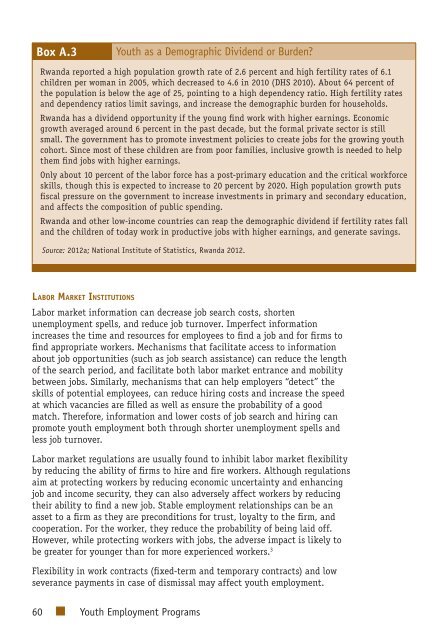Youth Employment Programs - Independent Evaluation Group
Youth Employment Programs - Independent Evaluation Group
Youth Employment Programs - Independent Evaluation Group
You also want an ePaper? Increase the reach of your titles
YUMPU automatically turns print PDFs into web optimized ePapers that Google loves.
Box A.3<strong>Youth</strong> as a Demographic Dividend or Burden?Rwanda reported a high population growth rate of 2.6 percent and high fertility rates of 6.1children per woman in 2005, which decreased to 4.6 in 2010 (DHS 2010). About 64 percent ofthe population is below the age of 25, pointing to a high dependency ratio. High fertility ratesand dependency ratios limit savings, and increase the demographic burden for households.Rwanda has a dividend opportunity if the young find work with higher earnings. Economicgrowth averaged around 6 percent in the past decade, but the formal private sector is stillsmall. The government has to promote investment policies to create jobs for the growing youthcohort. Since most of these children are from poor families, inclusive growth is needed to helpthem find jobs with higher earnings.Only about 10 percent of the labor force has a post-primary education and the critical workforceskills, though this is expected to increase to 20 percent by 2020. High population growth putsfiscal pressure on the government to increase investments in primary and secondary education,and affects the composition of public spending.Rwanda and other low-income countries can reap the demographic dividend if fertility rates falland the children of today work in productive jobs with higher earnings, and generate savings.Source: 2012a; National Institute of Statistics, Rwanda 2012.Labor Market InstitutionsLabor market information can decrease job search costs, shortenunemployment spells, and reduce job turnover. Imperfect informationincreases the time and resources for employees to find a job and for firms tofind appropriate workers. Mechanisms that facilitate access to informationabout job opportunities (such as job search assistance) can reduce the lengthof the search period, and facilitate both labor market entrance and mobilitybetween jobs. Similarly, mechanisms that can help employers “detect” theskills of potential employees, can reduce hiring costs and increase the speedat which vacancies are filled as well as ensure the probability of a goodmatch. Therefore, information and lower costs of job search and hiring canpromote youth employment both through shorter unemployment spells andless job turnover.Labor market regulations are usually found to inhibit labor market flexibilityby reducing the ability of firms to hire and fire workers. Although regulationsaim at protecting workers by reducing economic uncertainty and enhancingjob and income security, they can also adversely affect workers by reducingtheir ability to find a new job. Stable employment relationships can be anasset to a firm as they are preconditions for trust, loyalty to the firm, andcooperation. For the worker, they reduce the probability of being laid off.However, while protecting workers with jobs, the adverse impact is likely tobe greater for younger than for more experienced workers. 3Flexibility in work contracts (fixed-term and temporary contracts) and lowseverance payments in case of dismissal may affect youth employment.60 <strong>Youth</strong> <strong>Employment</strong> <strong>Programs</strong>
















